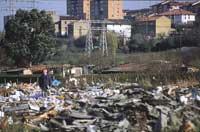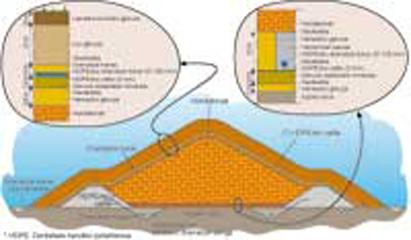Lindane, between chaos and solution
The problem needs a solution
The debate that has arisen around the security cells for the storage of lands contaminated by industrial waste (lindane, HCH or slags and powders from inorganic and metallurgical processes) must start from two parallel points of view. First, it is necessary to know and become aware of the problem, and above all the awareness, since to find solutions we must go to join efforts of all (neighbors, political groups, social groups, etc. ). ). And on the other hand, to be able to take the most appropriate option from among the options with an acceptable cost, it is necessary to know well all the techniques available.

Very recently in Australia there has been a debate similar to what we have here, but with a small difference: the problem they have there are residues that cannot be treated and the soil here contaminated. Among these products is the pesticide HCB, lindane or HCH.
Despite the differences, this debate drew a series of ideas and conclusions that can serve to better understand the situation of Euskal Herria:
- People trust technicians to solve the problem.
- The citizen is not aware of the seriousness of many environmental problems.
- The proposed solution is not a timely solution, but one that has been considered adequate in the long term.
There is a unique methodology for solving an environmental problem, applicable in each period, which focuses on prevention and recycling. Where this is not possible, the product itself or its risks should be eliminated.
The problem we have in the CAPV is complex, both HCH and lindane residue are mixed with slag and steel powders from the production of sulfuric products or even aluminum slag. And in general, all the consequences left by a rapid development model that has shown no concern for the environment. The legacy of then is the present one.
If in this context we try to implement the aforementioned methodology, we immediately see that prevention and recycling have no place due to the large amount of organic and inorganic waste (HGH, hydrocarbons, heavy metal…) and the mixture of the original land. Of course, this would require a split on two levels: first separate the land from the waste and then the waste itself.
The separation between residues of different physical-chemical composition and soil can be done through thermal, mechanical and/or physical-chemical processes, but taking into account the peculiarities of the existing landfills on the left bank of the Nervión River, the following aspects cannot be ruled out:
- The percentage of waste in this region is very high.
- If we want to separate pure waste and use it for recycling or other purposes, we would not achieve minimal quality.
- The cost of soil and waste separation would be enormous, we would not have a budget and remember that we would still have to separate and manage the waste itself.
Therefore, we cannot eliminate waste, but we should try to minimize risk and its possible environmental impacts. Therefore, the only solution we have for now is to accumulate it in the safety cell, as long as there is no technology that does not adversely affect the environment at acceptable costs. The Safety Cell shall comply with the industrial structure or installation, as well as the rules applicable to any structure containing chemicals. The question that is presented to us, therefore, must be simple: the citizen must know what the real problem is and know what the current solution is.

I work day by day with Lindane and from that experience I have frequently wondered what would be the debate reflected in the media if IHOBE had not taken any steps to solve this serious pollution problem in 37 CAPV sites. I will never know to ask for solutions that will act with the same force they demonstrate to criticize the solutions we want to launch. I think we have devised and adapted the native version of the American NIMBY syndrome (not in my back yard: no infrastructure next to my house).
The American NIMBY is debatable and the Basque AEGEAN (not with Gure Etxe) seems to me to be hopeful. In front of our houses we have half a million tons of land contaminated by HGH dispersed and some appear much more concerned about the detail of the solution than the current problem. This DOUE adds, therefore, to the classical negation generated by centralized infrastructure, which we do not want to give way to a problem that is only ours.
I hope, in any case, that this debate will help us all mature more in environmental management, both when it comes to knowing the problems and collecting information, and when it comes to approving existing solutions.
What is the Security Cell?
Safety cells are structures that allow storing hazardous substances or materials as required by their characteristics and potential risk. That is, they are structures that isolate these substances and prevent them from reaching the environment.

For building the safety cell you should first select the appropriate location. Once the selection is made, the soil is prepared and the insulating layer of the soil is placed. This insulating layer is a structure composed of natural, synthetic and mineral components that prevent waste from reaching the environment. Therefore, it must be totally waterproof. To provide maximum safety possible, the insulating layer consists of a layer of high density polyethylene of millimeter and medium thickness, a mineral layer and a natural layer.
In addition, to prevent the layer from being punctured, geotextiles are interspersed. Once the insulating underlayer is placed, the drainage system or the control of the lisibiates is placed. The drainage system aims to eliminate filtered water and waste stored during the construction of the tank. To do this, between several layers of permeable materials such as sand or gravel there is a network of pipes that facilitates the evacuation of water, together with a drainage system that collects and controls all drained liquids.
Once the bottom drainage layer is finished, another geotextile is placed on which the lands contaminated by HGH are deposited. Once the contaminated land is removed from the pouring area and transported to the reservoir site, the soil is leveled and crushed into layers of about 40 centimeters.
All personnel involved in the extraction, transport and storage of contaminated land should take security measures such as face protection and the turbomotor provided with active carbon filters.
Once the waste is deposited at the site, the insulating top layer will be placed to prevent rain water from entering the tank. Like the lower layer, it consists of natural, mineral and synthetic components, adopting the same control measures that have been adopted for the placement of the lower: geotextile and upper drainage. Finally, the entire warehouse is covered with land and plants are planted to restore the environment.
Buletina
Bidali zure helbide elektronikoa eta jaso asteroko buletina zure sarrera-ontzian











